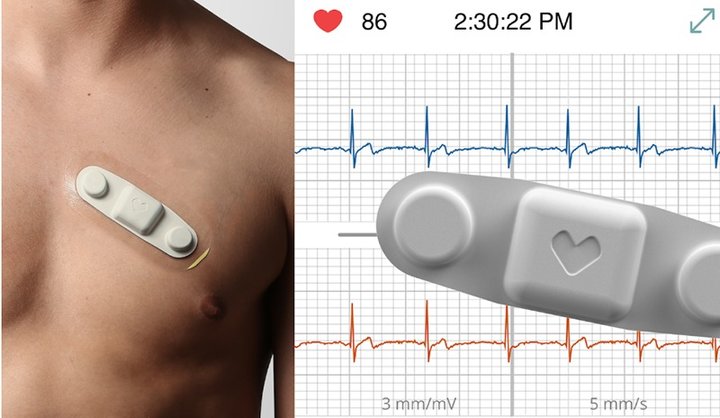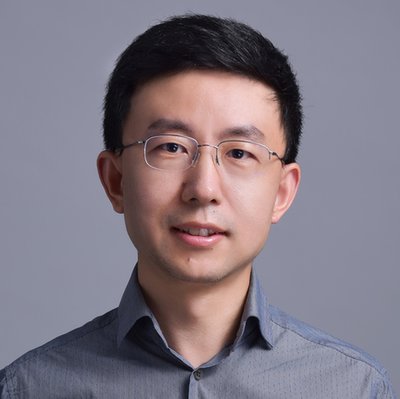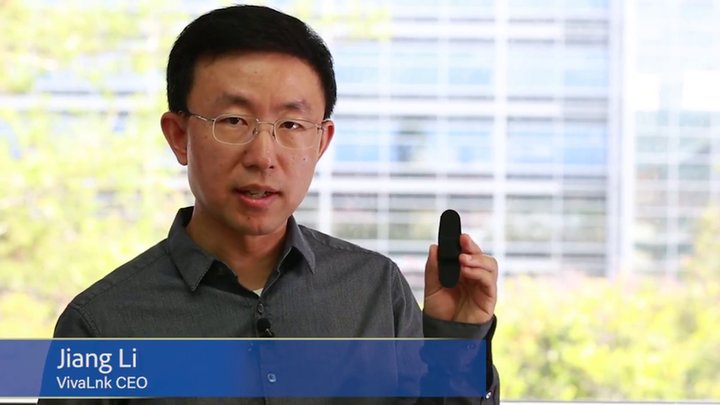VivaLNK
Internet of Health Things for Cardiac Telemetry
Digital health innovators are making big leaps in remote cardiac monitoring, responding to healthcare organizations interest in streamlining patient management and to consumer wellness trends. Yet few have managed to reach so far and be as user-friendly as a company that unlocks the data it collects to others developing health-enhancing solutions and whose sensors feel like a second skin.
By Gergana Koleva
Multi-sensor vitals tracking
VivaLNK, a Silicon Valley-based startup, runs a sophisticated remote patient monitoring (RPM) model that combines sensor technology, medical-grade data extraction, secure connectivity, cloud capabilities for data management and storage, and a la carte data partnerships with health service organizations looking to optimize patient care. Seizing on a current trend toward ever more inconspicuous biosensors, it has developed a reusable, multi-vital ECG patch based on its eSkin technology, which was first introduced in 2014, the year of its founding. The patch integrates multiple vitals and biometrics for tracking ECG rhythm, heart rate, respiratory rate, and activity, with future plans for measuring blood pressure. It can also be used with the company’s temperature patch to track axillary body temperature. Both the ECG and temperature patch are marketed to health tech companies and research organizations that want to develop medical applications and RPM solutions based on such data.
“What we are trying to do is combine ECG with other sensor capabilities to have monitoring of different types of cardiovascular disease. The current most prominent type of monitoring is arrhythmia cardiac devices, but that´s a very small segment,” says VivaLNK CEO Jiang Li, who contrasts the $2 billion arrhythmia monitoring market with the “hundreds of billions” of dollars´ worth of the cardiovascular disease market as a whole. “We believe that in order to properly diagnose heart disease through RPM, we need multiple vitals to come together and that´s why the multi-vital patch is the way to go.”
Patient usability
Road ahead
One of the features that differentiate VivaLNK´s cardiac monitoring device from other leading patch products is its form, which is smaller than iRhythm´s Zio and BardyDx´s CAM patches and comes in the shape of a Band-Aid, measuring 90 by 28 mm and weighing just 7.5 grams. Its eSkin technology, which promotes maximum adherence to the users´ skin, thus allowing the electrical signal from the heart to be optimally collected, is another plus.
Yet another characteristic that sets it apart from the competition is that although it is also apt for long-term wear (the Zio and CAM patches´ shelf life is between 7-14 days), unlike them it is reusable. Instead, it has a 72-hour rechargeable battery and comes with an SDK that includes a charging case, USB cable, and medical adhesives. Li. says this is one of the effects of keeping the user´s needs front and center.
“That was a key issue when we designed this device. We want patients to own it for a long time and use it in their daily life, so we tried to design it in a human way and make it attractive for the average person.”
As healthcare is increasingly looking to transform legacy processes that situate the hospital as the center of (mostly reactive) patient care and shift the focus towards preventive, home-based settings, there is a parallel trend happening on the technology side, with a growing number of health- and medtech organizations journeying to the cloud in order to innovate more quickly.
In this climate of reorientation, one might think that VivaLNK has its finger on the pulse of both currents – and Li says as much.
“In the next 5-10 years I think the value-based healthcare space is going to have a lot of changes. Overall where I see it moving forward is toward remote monitoring, remote patient management, and preventive care rather than just taking care of patients in the hospital. And to achieve these big goals, we need the necessary infrastructure. Our role is to try to enable a lot of the services in that space.”
Internet of Health Things (IoHT) platform
Notwithstanding VivaLNK´s revolutionary patch design and intuitive multi-sensor technology across its family of patches (in addition to the ECG Monitor, there are also the Vital Scout and the Fever Scout), its unique value proposition to the cardiac telemetry market in particular and to the RPM market in general is its proprietary cloud-based Sensor Platform. The platform represents a data lake where all the data
points captured by the company´s sensors end up after passing through intermediary devices, such as smartphones or data hubs, that speed up traffic of voluminous data by pre-processing it close to the source (e.g. the patient´s environment). Once in the cloud, the information can be accessed by VivaLNK´s more than 70 solutions partners – health technology companies, hospitals, and research institutions – via “data streams”, or categories, such as ECG rhythms, heart and respiratory rates, temperature or blood pressure, depending on the service verticals of each customer.
To position itself as a serious data partner, VivaLNK´s system infrastructure accounts for possible disruptions of wireless networks and has a method for caching and synchronizing information between the sensors, the cloud, and external applications, such that no patient data is ever lost or incomplete.
“The key to obtaining premium data from RPM is the connectivity question. With wireless networks it´s hard to always connect with your mobile device or data hub, so we did a lot of work in our software to make sure even in the event of a disconnection, we have the right mechanism to retrieve the data and piece it together, so that the doctor sees a complete dataset without any missing data,” explains Li, referring to the end user of VivaLNK’s product.

Enterprise use cases
By partnering with VivaLNK and purchasing a license to the data, or by using the startup´s patches directly, healthcare organizations can address various challenges: alleviate clinical workflows by automating vital sign tracking for patients on hospitals wards or at home, help staff at nursing homes identify early signs of patient deterioration, or build proprietary machine learning and predictive algorithms by having ready access to retrospective trend analysis.
One company taking advantage of the capabilities of the ECG patch is Myia Health, a health tracking platform that helps hospitals reduce readmissions of heart failure surgery patients by providing post-discharge event monitoring.
Citing that partnership, Li explains the founding vision of VivaLNK: instead of developing specific vertical solutions, the startup chose to take “the Amazon Cloud approach” by enabling and empowering collaborators to do so themselves. The assumption – proven correct in hindsight – was that storing real-world data on the platform would reduce the imperative for other health technology companies to develop their own sensors, since they could tap directly into VivaLNK´s devices and data to build and accelerate to market their own medical applications.
“The majority of companies that are providing healthcare services at home or through patient monitoring do not have the ability to develop their own medical devices. We are trying to fill the void by providing a way for them to connect a sensor to the services they are building and offering to the end user – hospitals or consumers. We are enabling that ecosystem,” says Li.
In addition to Myia and a number of other commercial partners, VivaLNK counts among its collaborators a host of academic institutions as well, including Stanford, UCSF Medical School, and Emory University, which is using its cardiac patch to remotely monitor patients undergoing coronary angiography and predict their probability of developing coronary artery disease.

In order to properly diagnose heart disease through remote patient monitoring , we need multiple vitals to come together and that´s why the multi-vital patch is the way to go.
Battery life was a key issue when we designed the device. We want patients to own it for a long time and use it in their daily life, so we tried to design it in a human way and make it attractive for the normal person.
Our unique value proposition to the remote patient monitoring market is the proprietary cloud-based Sensor Platform. Storing real-world data on the platform would reduce the imperative for other health technology companies to develop their own sensors, since they could tap directly into VivaLNK´s data to build and accelerate to market their own medical applications.
Jiang Li, Founder & CEO - VivaLNK

